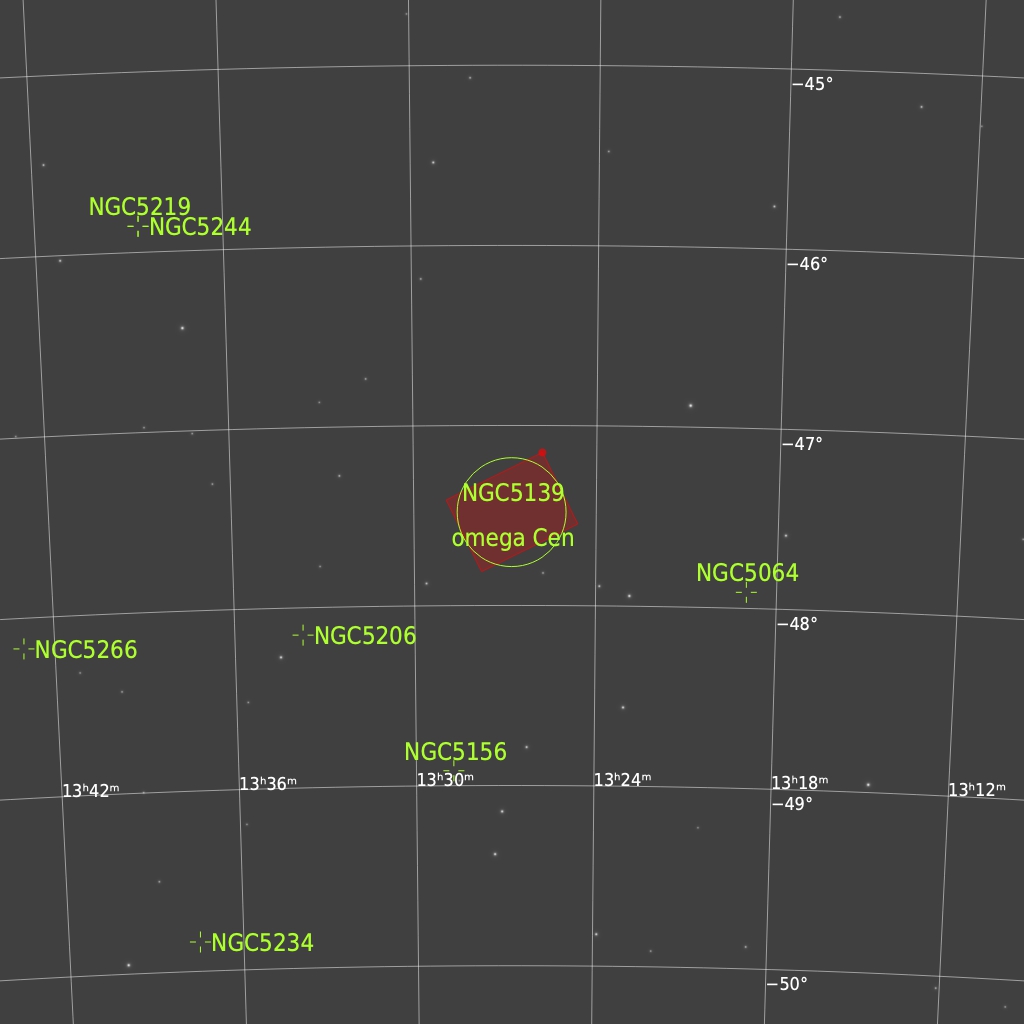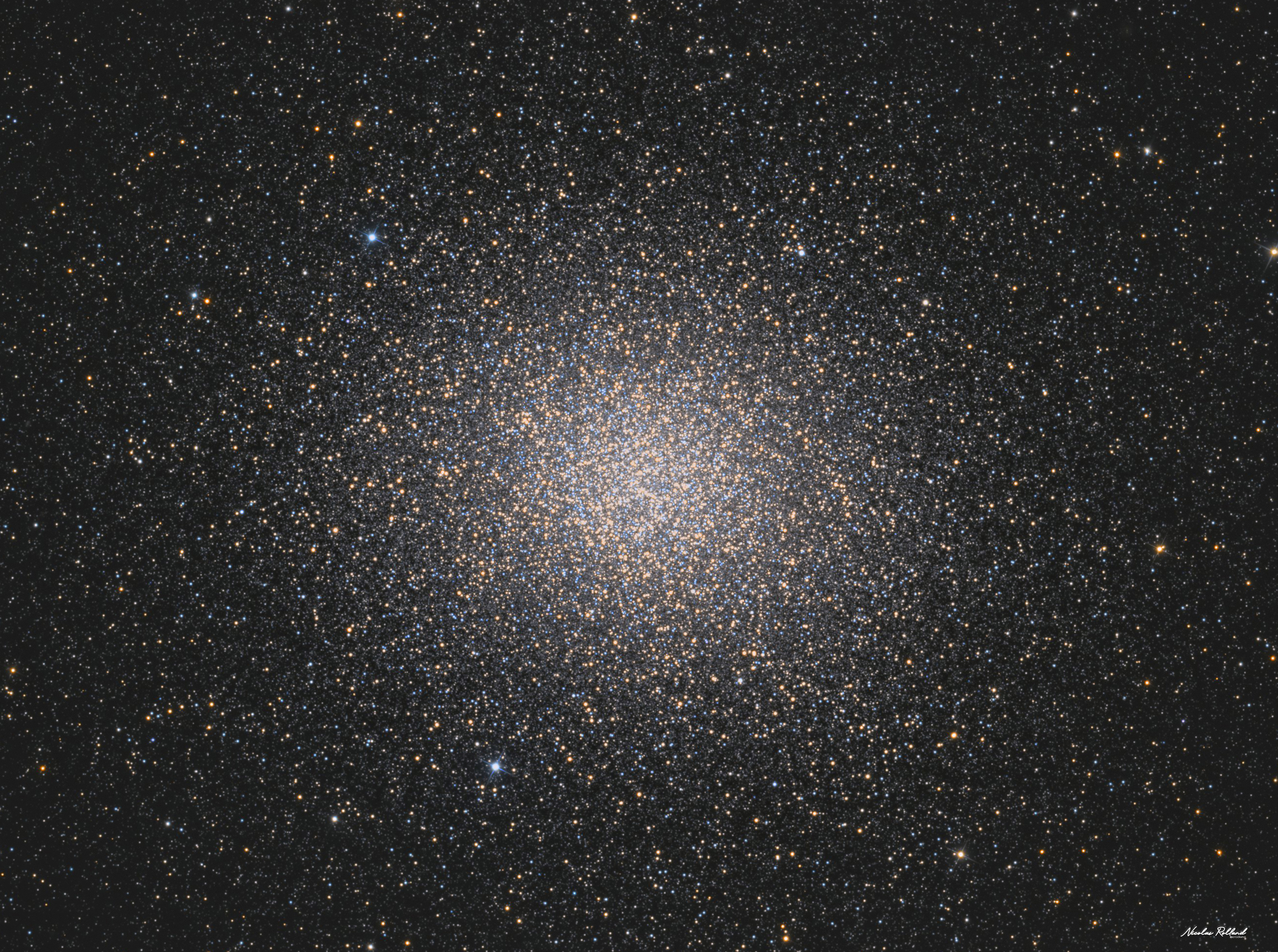Omega Centauri
NGC 5139
Omega Centauri (ω Cen) is a globular cluster in the constellation Centaurus. It is observed since antiquity and was originally catalogued as a star. In several aspects, ω Cen is different from other globular clusters present in the Milky Way, so that a hypothesis supports that it could be the remains of a dwarf galaxy.
ω Cen is located at about 15,700 light years from the solar system and has a diameter of about 253 light years, making it the largest globular cluster in the Milky Way. A total of 10 million stars would be contained in this cluster for a mass of about 4 million solar masses. In the center, the density of stars is so high that the distance between each of them is estimated to be about 0.1 light years.
The diversity of stars cohabiting in the cluster indicates that several generations of stars have succeeded each other.
Those clues reinforce the idea that ω Cen could be the remains of the nucleus of a dwarf galaxy whose periphery would have been dispersed and absorbed by the Milky Way, becoming ω Cen. Beyond the dispersion of stars, the orbital speed of the latter is high (7.9 km/s), its flattened shape and the presence in its center of an intermediate black hole of 12,000 solar masses support this hypothesis.
Omega Centauri (ω Cen) est un amas globulaire situé dans la constellation du Centaure. Des traces de son observation montrent qu’il est observé depuis l’antiquité et qu’il a été initialement catalogué comme une étoile.
Sous plusieurs aspects, ω Cen se distingue des autres amas globulaires présents dans la Voie lactée, si bien qu’une hypothèse étaye qu’il pourrait s’agir des restes d’une galaxie naine.
ω Cen se situe à environ 15 700 années-lumière du système solaire et possède un diamètre d’environ 253 années-lumière, faisant de lui le plus vaste amas globulaire de la Voie lactée. Un total de 10 millions d’étoiles serait contenu dans cet amas pour une masse d’environ 4 millions de masses solaires. Au centre, la densité des étoiles est tellement importante que l’on estime la distance qui sépare chacune d’elles à environ 0,1 année-lumière.
La grande diversité d’étoiles cohabitant dans l’amas indique que plusieurs générations d’étoiles se sont succédé.
Ces éléments renforcent l’idée que ω Cen serait les restes du noyau d’une galaxie naine dont la périphérie aurait été dispersée et absorbée par la Voie lactée. Le noyau de cette dernière se serait finalement retrouvé en orbite dans le halo de la Voie lactée, devenant ω Cen. Au-delà de la dispersion des étoiles, la vitesse orbitale de ces dernières est élevée (7,9 km/s), sa forme aplatie et la présence en son centre d’un trou noir intermédiaire de 12 000 masses solaires appuient cette hypothèse.
TECHNICAL DATA
ACQUISITION DETAILS
OPTICS Planewave CDK17 @ F/6.8
CAMERA SBIG STXL-11002 (AOX)
MOUNT Paramount ME
FILTERS L, R, G, B
LOCATION Yass, New South Whales, Australie
DATE May 2020
EXPOSURES 4,3 hours (L 6 x 600 sec, R 7 x 600 sec, G 6 x 600 sec, B 6 x 600 sec)
PROCESSING SOFTWARE Pixinsight, CCDstack, Photoshop
COPYRIGHTS Martin Pugh & Nicolas Rolland

TARGET DETAILS
RA 13h 26m 46.2s
DEC -47° 28' 50.4"
SIZE 35.8 x 26.6 arcmin
ORIENTATION Up is 154 degrees E of N
CONSTELLATION Centaurus
DISTANCE 15 700 ly
MAGNITUDE 5,3
